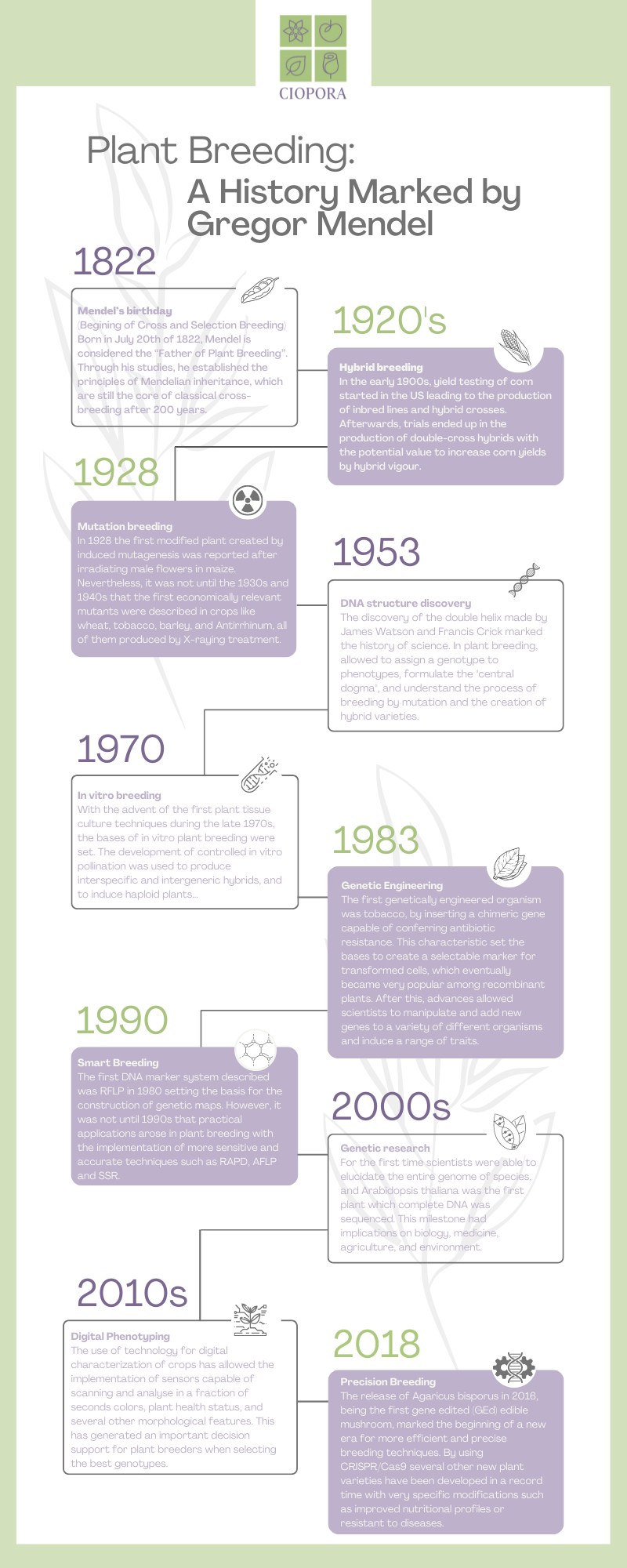Following the Path of Gregor Medel
- CIOPORA
- Jul 20, 2022
- 4 min read
Updated: Jul 21, 2022
In the frame of the 200 anniversary of the father of genetics, the CIOPORA team developed a timeline with the milestones of plant breeding since Mendel’s discovery.
There are not many cases in science in which the discovery of something can be attributed to a single person. However, this is the case with Gregor Mendel, an Augustinian monk and scientist, who is known as the father of genetics thanks, among other things, to the determination of the patterns of simple inheritance.
After years of crossing pea (Pisum sativum), Mendel published in 1865 his discoveries and established three basic rules of heredity:
Mendel’s First Rule or Uniformity Rule
If you cross two pure-bred parents who differ in one characteristic, all offspring will be genotypically and phenotypically the same (uniform).
Mendel’s Second Rule or Splitting Rule
With crosses of homozygous parents who differ in two characteristics (dihybrid inheritance), the respective hereditary traits are passed on freely and independently of each other to the offspring.
Mendel’s Third Rule or Independence Rule
In a cross between heterozygous individuals, the offspring will split in both genotype and phenotype – and always according to a certain numerical ratio.
Since Mendel's discoveries, there have been several milestones in plant breeding, and we would like to share with you this interesting document produced by our team:

1822 - Mendel’s birthday (Cross and Selection Breeding)
Born in July 20th of 1822, Mendel is considered the “Father of Plant Breeding”. Through his studies, he established the principles of Mendelian inheritance, which are still core of classical cross-breeding
after 200 years.
1920’s - Hybrid breeding (first commercial corn hybrid)
In the early 1900s, yield testing of corn started in the US leading to the production of inbred lines and hybrid crosses. Afterwards, trials ended up in the production of double-cross hybrids with the potential value to increase corn yields by hybrid vigour. By 1910s double-cross technique permitted hybrid seeds to be produced in quantity at a reasonable cost, and with it the beginning of hybrid breeding after the release of the first commercial cross hybrid in 1921.
1928 - Mutation breeding
In 1928 the first modified plant created by induced mutagenesis was reported after irradiating male flowers in maize. Nevertheless, it was not until the 1930s and 1940s that the first economically relevant mutants were described in crops like wheat, tobacco, barley, and Antirrhinum, all of them produced by X-raying treatment.
1953 - DNA structure discovery
The discovery of the double helix made by James Watson and Francis Crick marked the history of science. In plant breeding, allowed to assign a genotype to phenotypes, formulate the "central dogma", and understand the process of breeding by mutation and the creation of hybrid varieties.
1970’s - In vitro breeding
With the advent of the first plant tissue culture techniques during the late 1970s, the bases of in vitro plant breeding were set. The development of controlled in vitro pollination was used to produce interspecific and intergeneric hybrids, and to induce haploid plants. Moreover, embryo, and ovule cultures contributed to overcome sexual incompatibility and seed dormancy. Afterwards in 1980s, protoplast culture and selection of variants play a part in the release of new varieties.
Thorpe, T. A. (2007). History of plant tissue culture. Molecular Biotechnology, 37(2), 169–180. doi:10.1007/s12033-007-0031-3
1983 - Genetic Engineering
The first genetically engineered organism was tobacco, by inserting a chimeric gene capable of conferring antibiotic resistance. This characteristic set the bases to create a selectable marker for transformed cells, which eventually became very popular among recombinant plants. After this, advances allowed scientists to manipulate and add new genes to a variety of different organisms and induce a range of traits.
Lemaux, P. G. (2008). Genetically Engineered Plants and Foods: A Scientist’s Analysis of the Issues (Part I). Annual Review of Plant Biology, 59(1), 771–812. doi:10.1146/annurev.arplant.58.03
1990s - Smart Breeding (Molecular Markers Assisted Selection)
The first DNA marker system described was RFLP in 1980 setting the basis for the construction of genetic maps. However, it was not until 1990s that practical applications arose in plant breeding with the implementation of more sensitive and accurate techniques such as RAPD, AFLP and SSR.
Ben-Ari, G., & Lavi, U. (2012). Marker-assisted selection in plant breeding. Plant Biotechnology and Agriculture, 163–184. doi:10.1016/b978-0-12-381466-1.000
2000s - Genetic research
For the first time scientists were able to elucidate the entire genome of species, and Arabidopsis thaliana was the first plant which complete DNA was sequenced. This milestone had implications on biology, medicine, agriculture, and environment.
2010s - Digital Phenotyping
The use of technology for digital characterization of crops has allowed the implementation of sensors capable of scanning and analyse in a fraction of seconds colors, plant health status, and several other morphological features. This has generated an important decision support for plant breeders when selecting the best genotypes.
Omari MK, Lee J, Faqeerzada MA, Joshi R, Park E, Cho BK. 2020. Digital image-based plant phenotyping: a review. Korean Journal of Agricultural Science 47:119-130. https://doi.org/10.7744/kjoas.20200004
2016 - Precision Breeding
The release of Agaricus bisporus in 2016, being the first gene edited (GEd) edible mushroom, marked the beginning of a new era for more efficient and precise breeding techniques. By using CRISPR/Cas9 several other new plant varieties have been developed in a record time with very specific modifications such as improved nutritional profiles or resistant to diseases.

Comments